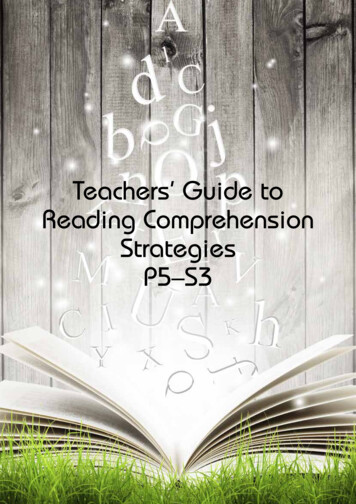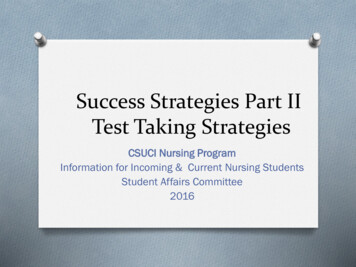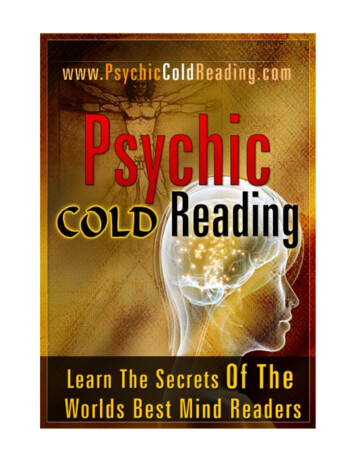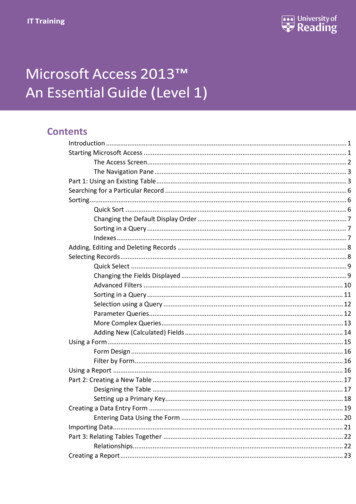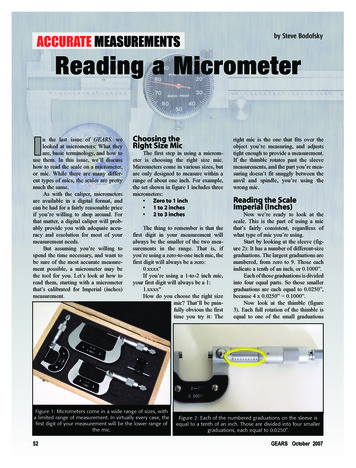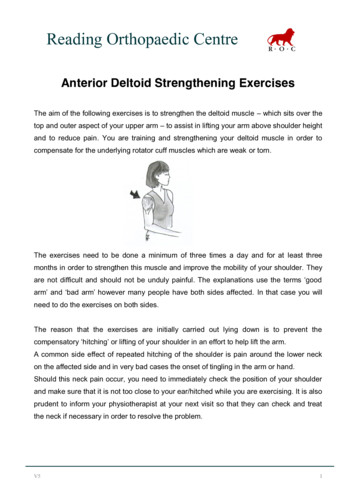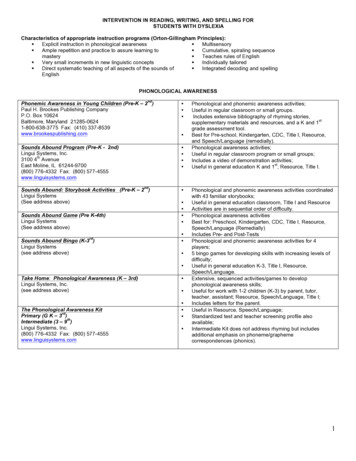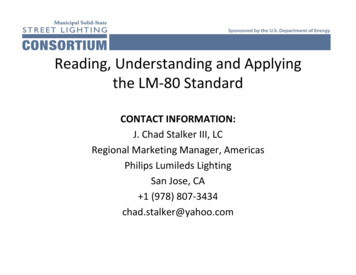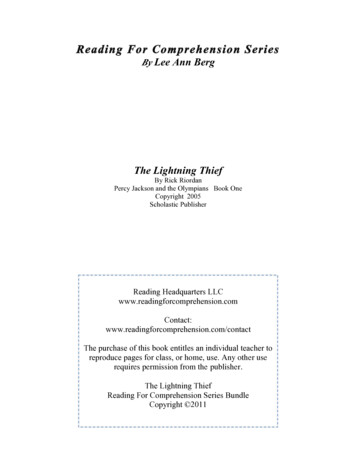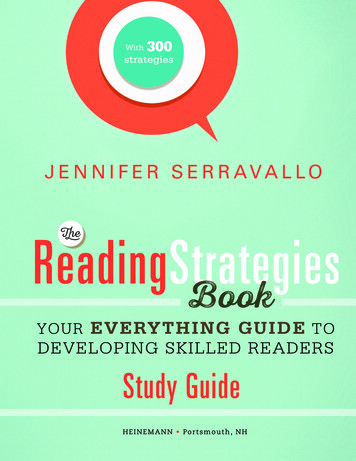
Transcription
With300strategiesJ E N N I F E R S E R R AVA L LOKReadingStrategiesBookYOUR EVERYTHING GUIDE TODEVELOPING SKILLED READERSStudy GuideH E I N E M A N N Po r t s m o u t h , N H
Heinemann361 Hanover StreetPortsmouth, NH 03801–3912www.heinemann.comOffices and agents throughout the world 2015 by Jennifer SerravalloAll rights reserved. No part of this guide may be reproduced in any form or by anyelectronic or mechanical means, including information storage and retrieval systems,without permission in writing from the publisher, except by a reviewer, who may quotebrief passages in a review; and with the exception of reproducibles (identified by TheReading Strategies Book Study Guide copyright line), which may be photocopied forclassroom use.“Dedicated to Teachers” is a trademark of Greenwood Publishing Group, Inc.The author and publisher wish to thank those who have generously given permission toreprint borrowed material:Hierarchy of Possible Goals, Goals-Skills-Strategies, Six-Week Schedule, PromptingReaders, Gradual Release, Plot vs. Theme, and Mistakes Can Lead to Lessons from TheReading Strategies Book by Jennifer Serravallo. Copyright 2015 by Jennifer Serravallo.Published by Heinemann, Portsmouth, NH. All rights reserved.Screenshot from the Heinemann Digital Campus course Teaching Reading in SmallGroups by Jennifer Serravallo. Copyright 2013 by Heinemann, Portsmouth, NH. Allrights reserved.Planning Your Week, Class Profile, and Independent Reading Assessment forms fromIndependent Reading Assessment: Fiction by Jennifer Serravallo. Copyright 2012 byJennifer Serravallo. Published by Scholastic Inc. Reprinted by permission of the publisher.Previously reprinted with permission in Serravallo’s The Literacy Teacher’s Playbook,Grades K–2, and The Literacy Teacher’s Playbook, Grades 3–6, published by Heinemann.
Contents32AppendicesLinks to student work samples 29Planning Your Week form 30Class Profile form 31A Curriculum of Talk form 321Welcome1. How Do I Know What to Teach? 52. R evise Your Curriculum to be MoreSpecific 73. Imagine the Course 84. Visualize It 105. From Page to Practice 126. Create a Toolkit 137. Mark Up a Demo Text 148. R evise Your Guided ReadingLessons to be More Explicit 159. Planning Prompts 1610. Author New Strategies 1811. Balancing Whole-Classand Individual Goals 1912. Moving to a New Level 2113. One Strategy, Many Twists 2214. Plan a Curriculum of Talk 2315. P lan a Curriculum of WritingAbout Reading 2416. What Does “Got It” Look Like? 2517. Studying Support 2618. Teach, Review, Respond 28A Curriculum of Writing About Reading form 33Guided Reading Planning Sheet 34Bibliography 36
WelcomeAn Introduction to the Study GuideI’m so happy you’ve chosen to study The Reading Strategies Book with colleagues! Takingthe opportunity to try out material in the book alongside other teachers and leaders in aschool has the potential to help your practice grow exponentially. I’ve put together thisguide to jump-start collaboration by including ideas for how I might guide your practiceif I were there with you.I’ve included ideas in this guide that will work well in discussion groups or meetings,and others that will work well when you practice inside a classroom with students. If yourschedule doesn’t allow you to teach alongside another teacher while school is in session,you may also consider filming your teaching and sharing it during after-school hours.One note about this: opening up your classroom (literally or with transcripts and videos)might seem a little nerve-wracking at first, but doing so will provide endless opportunities for thoughtful reflection and revision of best practices. I highly recommend trying!For fun and easy reference, I decided to format this study guide like I do the strategiesin The Reading Strategies Book. Each collaboration suggestion has: A Title A Procedure: a clear, step-by-step process for the activity A Level: a marginal denotation as a “beginner,” “intermediate,” or “advanced”activity. Some are marked acceptable for “any” and there are notes within thepage to understand how to adapt for teachers of differing experience levels. Book to Book: cross-references to my other books, for those of you who havethem, to help you understand how my books fit together1
Setting: a suggestion for whether this works best at a teacher meeting (such asa PLC or faculty meeting) or while working in classrooms with children (suchas a lab site) Coaching Tips: a more in-depth discussion of how to do the activity withcolleagues, as well as some sidebar notes I’d likely tell you if I were there withyou as you practice.Below, you’ll find an overview table of all eighteen suggestions at a glance.I hope you find this to be an easy-to-follow guide that offers ideas for conversations,activities, and practices that will not only strengthen your strategic reading instruction,but will also strengthen collaboration with your colleagues.2TitleLevelBook to BookSetting1How Do I Know What to Teach?AnyEither of the PlaybooksMeeting room2Revise Your Curriculum to be More SpecificAnyEither of the PlaybooksMeeting room3Imagine the CourseAnyConferring with Readers or Teaching Readingin Small GroupsMeeting room4Visualize ItAnyThe Reading Strategies BookMeeting room5From Page to PracticeAnyConferring with Readers or Teaching Readingin Small GroupsClassroom6Create a ToolkitAnyThe Reading Strategies BookMeeting room7Mark Up a Demo TextAnyTeaching Reading in Small GroupsMeeting room8Revise Your Guided Reading Lessons to be More ExplicitBeginner orIntermediateEither of the Playbooks and Teaching Readingin Small GroupsMeeting room9Planning PromptsBeginner orIntermediateTeaching Reading in Small Groups and The ReadingStrategies BookMeeting room10Author New StrategiesIntermediateTeaching Reading in Small GroupsMeeting room11Balancing Whole-Class and Individual GoalsIntermediateTeaching Reading to Small Groups, either of thePlaybooks, and Conferring with ReadersMeeting room12Moving to a New LevelIntermediate orAdvancedEither of the Playbooks and Teaching Readingin Small GroupsMeeting room13One Strategy, Many TwistsIntermediate orAdvancedConferring with Readers and Teaching Readingin Small GroupsClassroom14Plan a Curriculum of TalkIntermediate orAdvancedTeaching Reading in Small Groups, either of thePlaybooks, and Conferring with ReadersMeeting room15Plan a Curriculum of Writing About ReadingIntermediate orAdvancedTeaching Reading in Small Groups, either of thePlaybooks, and Conferring with ReadersMeeting room16What Does “Got It” Look Like?Intermediate orAdvancedEither of the PlaybooksMeeting room17Studying SupportAdvancedTeaching Reading in Small Groups or Conferringwith ReadersClassroom18Teach, Review, RespondAdvancedEither of the PlaybooksMeeting roomTHE READING STRATEGIES BOOK Study Guide
Procedure: For quick7. Mark Up a Demo TextChoose this when . . .LEVELSreference, the proceduresummarizes the stepsinvolved in the professionallearning activity.Procedure Find a rich text that you plan to read aloud to your class. One strategy ata time, mark up the text with possible places to demonstrate. You may want to includenotes about the strategy on the sticky note you use.anyCoaching Tips I learned from Carl Anderson many years ago that it’s helpful toconfer with a “text under your arm” (2000) so that when you need to give a quickBOOK TO BOOKCoaching Tips: These are notes,See Teaching Readingcoach to coach, that include helpfulSKILLinSmall Groupstips and more elaborated advice onhowDecoding,usingforpagesto engage in the professional learning 117–121Structureas a Sourcemorediscussionactivity. At times, there is also adviceforwhen to chooseaboutof Informationmaking the activity more simple ordemonstrationmoreas asophisticated depending on the groupof and pagesmethod,114–116 to learnteachers who are practicing.example or demonstrate a strategy, the text is right there at your fingertips. This will savetime since you won’t need to run back to your desk or easel ledge to retrieve the book youwanted to use.To make this text easy to use, I recommend reading the text aloud to the class duringan interactive read-aloud so the children are very familiar with it. That way, when you’rein the midst of a conference or small group you’ll be able to quickly turn to a page to reference a small part, saving time in your teaching.more about how tomake demonstrationspowerful.SETTINGmeeting room143THE READING STRATEGIES BOOK Study GuideTHE READING STRATEGIES BOOK Study Guide
Margins: The margins will guide you to findactivities for novice to more advance levelsof experience with strategies, references fromother books you may have by Jennifer Serravallo,and the optimal setting (meeting or classroom)for this activity.16. What Does “Got It” Look Like?Choose this when . . .Procedure Find one strategy that would work for at least one student in each teacher’sclassroom in the study group. Go back to your respective classrooms and teach the strat-LEVELSegy. Bring back something—a transcript, a sticky note, a recording, or a photo—to showintermediate oradvancedthe student’s learning or response to the strategy. Discuss which of the students seemed toBOOK TO BOOKFor more informationSKILLon what to expect ofDecoding,students atusingdifferentStructurea Sourcelevels (andashowtointerpretartifacts ofofInformationstudent learning) seeeither of the LiteracyTeacher’s Playbooks.“get it.”Coaching Tips In The Reading Strategies Book, you’ll find strategies and prompts tohelp nudge readers along as they practice. Looks simple, right? But here’s the thing— youneed to know when to use which prompt, when to decide to stop prompting, and evenwhen to move on to a new strategy. What will help you with this in-the-moment decision-making is doing some norming of expectations with you and your colleagues.You could practice this together as a group. Go into a classroom, teach a strategy to thewhole class or a group of kids, bring all of their responses back, and sort them into piles:“got it,” “kind of got it,” “didn’t get it.” Alternatively, you can each collect information fromyour own classes and bring the students’ work to a meeting to share and sort together.SETTINGBeyond just sorting into piles, you’ll then want to discuss why you put the work in themeeting room only,or classroom plusmeeting roomcategory you did, and what it means to “get it.”When you have a clear sense of what you’re looking for as the result of your strategy,you’ll be better able to guide readers in the midst of practicing, and support readers withnext steps as needed.Visuals: The visuals will help you toimagine what materials you’ll needin order to engage in the activity, willreference a visual from the book, and/or will show you a photograph of someteachers who are in the midst of tryingthe activity.254THE READING STRATEGIES BOOK Study GuideTHE READING STRATEGIES BOOK Study Guide
1. How Do I Know What to Teach?Choose this when . . .Procedure Read across the opening 2–3 pages of each of the thirteen goal chapters. Choose a student to study. Find assessment examples that will help you to under-LEVELSstand that student across the thirteen different categories. With colleagues, discuss whatanystrengths the child has and what an appropriate goal might be. Then, select appropriatestrategies that are tied to the student’s goal and reading level.BOOK TO BOOKSee either bookSKILLin The LiteracyDecoding,usingTeacher’s PlaybookStructurea Sourceseries for aasmorein-depthdiscussionofInformationof formativeassessments.Coaching Tips All the beautiful strategy instruction in the world will do little if it’snot grounded in what a child can already do, and what an appropriate next step for thatchild might be. Those who have read my Literacy Teacher’s Playbooks know that I valuethe stuff inside a child’s desk; informal assessments and everyday student work help meknow what to do. Artifacts such as book logs, reading notebook entries, stop-and-jots onsticky notes, and self-reflections count as data! Running records are invaluable for kindergarten and first-grade teachers. Other assessments you’ve created or purchased mayalso give you an idea of what students might need.SETTINGmeeting roomThe initial pages of each goal chapter in The Reading Strategies Book (see sections titled,“How do I know if this goal is right for my student?”) offer a very brief introduction tothe sorts of data you may collect that can be tied to each goal. If you consider yourself abeginner with this sort of thinking, I’d recommend collecting information for one goal,discussing the results with colleagues, and finding some strategies to teach children whowould benefit from the goal. Intermediate and advanced readers who may have read andpracticed the assessment protocols described in my Playbooks may choose to bring severalexamples of student work from across lenses to choose specific, individual goals.If you’re just getting started and want to try this activity without collecting materialsfrom students in your class, or if you’re a coach who is doing some professional learning with teachers outside of the normal school year without access to student work, I’drecommend downloading the work samples from the Playbooks. Two first-grade samplescan be found at www.heinemann.com/products/E05300.aspx. Two fourth-grade samplescan be found at www.heinemann.com/products/E04353.aspx.5THE READING STRATEGIES BOOK Study Guide
Determining Where to Start:A Hierarchy of Possible GoalsEmergent ReadingEngagementPrint WorkFluencyComprehensionFiction / LiteratureNonfiction / InformationPlot & SettingMain IdeaCharacterKey DetailsVocabulary & Figurative LanguageVocabularyThemes & IdeasText FeaturesConversationWriting About Reading6THE READING STRATEGIES BOOK Study Guide
2.32. RevisePurposesYourforCurriculumReading Start/Stopto be MoreMatSpecificChoose this when . . .Procedure Focus on one unit. Review the expected outcomes, goals, objectives, and/or enduring understandings. Think about your students’ reading levels and about whichLEVELSof the thirteen goals apply to the current unit. Using the overview tables within each unit,anyfind the appropriate lessons. Compare your current lessons to the lessons in the book.Coaching Tips For many of the districts I work with, teachers are clear on the unit ofBOOK TO BOOKHistoricalFor more informationFiction,SKILLfantasyon how especiallyto assess andDecoding,usingevaluate whatyourStructureas alreadya Sourcestudents aredoing,which willofInformationhelp you guide yourplanning, see eitherbook in The LiteracyTeacher’s Playbookseries, Chapters 1and 2.it. But sometimes the actual “how to teach this skill” aspect of the lesson is left to theSETTINGSETTINGeach unit.meeting roommeeting room7study topics, or if they are working with a basal reader series, the units that occur withinteacher to figure out.This activity will allow a grade-level team of teachers to plan for the nitty-gritty, dayto-day teaching. You may choose to use the strategies as they are written or revise intolanguage that’s more comfortable for you. What’s most important to keep in mind is thatyou’re equipping children with a strategy in every single lesson.One extension possibility is to brainstorm some of your own “lesson language” to fitwith your class read-aloud (feel free to use what’s in The Reading Strategies Book as amodel, but you’ll probably want to make it your own.) Another extension possibility isto work together to create anchor charts that will work for you and your students withinTHE READING STRATEGIES BOOK Study Guide
3. Imagine the CourseChoose this when . . .LEVELSProcedure Think of one student and that student’s one goal. Look through the entirechapter that connects to that student’s goal. Choose a series of strategies that seem tobuild from simple to more complex.anyCoaching Tips It’s unlikely that you’re going to plan out a 6-week course for each andevery reader in your classroom, and I wouldn’t recommend it! What’s most authentic isBOOK TO BOOKTo imagine differentSKILLstructures andDecoding,methods tousingmatch theStructureSourcestrategies asyoua choose,seeInformationeither Conferringofwith Readers orTeaching Reading inSmall Groups.that you teach a strategy, see how the student does, and then decide whether to move onto a new strategy or re-teach the same one. However, as an exercise in understanding andnavigating the book, you could work alone, or with your colleagues, to take an imaginaryreader—perhaps one you studied from the first exercise in this study guide—and findstrategies in the book that align to both the reader’s goal, as well as the level of text thestudent is reading. You could even invent some of your own strategies!The table on the following page (that’s been copied from page 10 of Strategies) ishow one reader’s 6-week journey went. Notice that all the strategies connect to the goaland the reading level.SETTINGmeeting roomGoal:(6 weeks)Themesand IdeasStrategy:Feelings HelpUs onseFrom The Reading Strategies Book, page 98THE READING STRATEGIES BOOK Study GuideSkill:SynthesisStrategy:CharacterChange CanRevealLessonsStrategy:Titles Can BeTelling
week 1Teacher (T) taught “Feelings Help Us Learn” in a conference. Student (S)practiced in Stone Fox and The Report Card, her self-selected books for theweek. T checked in at end of week in a small-group strategy lesson.week 2T taught “Actions, Outcomes, Response” in a small group. S practiced in Circleof Gold, her new self-selected book. S Seemed to struggle. T met with S onThursday in a conference to repeat lesson, offered a new example. S continuedreading The Whipping Boy, and practiced some more. T asked student to keeptrack of thinking in reader’s notebook.week 3T revisited “Actions, Outcomes, Response” in the first conference of the week.T decided S is doing well. Introduced “Character Change Can Reveal Lessons.”S chose Family Under the Bridge and Indian in the Cupboard this week.week 4S practiced last week’s strategy in Rules and Hatchet. At the end of the week,T reviewed the S’s work during a conference. T determined she could be moreuniversal in her language and coached the S to rephrase the statements she hadrecorded.week 5T met with S during two strategy lessons this week and helped her toincorporate all three new strategies, when appropriate, in her new books for theweek: Charlotte’s Web and Stuart Little.week 6T introduced “Titles Can Be Telling” in a conference and student seems able touse the strategy right away. S continued practicing all four strategies during theweek in two new books. At end of week, T decided to move to new goal.From The Reading Strategies Book, page 109THE READING STRATEGIES BOOK Study Guide
4. Visualize ItChoose this when . . .Procedure Read through all of the information about one strategy. Think of a studentyou want to teach this strategy to. Keeping in mind the age, stage of language acquisition,LEVELSlearning style, reading level, etc. of this student, create a visual that will work with thisanylesson, and for the student.Coaching Tips I included visuals for every lesson in the book for a few reasons.BOOK TO BOOKFor more supportSKILLwith creating charts,Decoding,please visitusingtheStructureas ofa nBook, pages 15–18.SETTINGmeeting roomInspired by the work of Marjorie Martinelli and Kristine Mraz (of chartchums [https://chartchums.wordpress.com/] and Smarter Charts fame [2012, 2014]) I wanted to challenge myself to imagine the language of the strategy and lessons as a visual for students.Martinelli and Mraz have convinced me that visuals help learning to stick—so I did it foryou, the teacher, in the hopes that seeing these visuals will help you commit these strategies to memory.You may find that some of the visuals in the book will work great as is with your ownkids. Fabulous! Feel free to copy. However, you may find that there are some visuals thatare intended for a different learner than the one in front of you. In this case, I hope youfeel comfortable enough to make your own! For example, take a quick look at Lesson7.2: “The Difference Between Plot and Theme” (page 195). I chose a book at level G andFrom The Reading Strategies Book, Lesson 7.2: “The Difference Between Plotand Theme”10THE READING STRATEGIES BOOK Study Guide
another at level K to give examples of this strategy. What if you teach middle school?They will run you out of the room with those examples! You’ll need to re-create the chartwith some examples that are more relevant to your class. Take a look at Lesson 7.7: “Mistakes Can Lead to Lessons” (page 200). I love the chart, but it’s really wordy. What if youhave an ELL, a younger student, or a child at a lower reading level, for whom that muchprint would be overwhelming? Can you reimagine the chart as a more picture- or iconheavy version?From The Reading Strategies Book, Lesson 7.7: “Mistakes Can Lead to Lessons”11THE READING STRATEGIES BOOK Study Guide
5. From Page to PracticeChoose this when . . .Procedure Choose a strategy that will benefit one student (conference) or a group ofstudents (strategy lesson). Read through the strategy, prompts, lesson language, and chartLEVELSso you feel comfortable with what you plan to teach. Teach in front of your colleaguesanyand receive feedback.Coaching Tips When I was a first-year teacher, fresh out of college, I tried very hardBOOK TO BOOKFor more supportSKILLwith conferences,Decoding,usingsee ConferringStructureas aForSourcewith Readers.moresupport withofInformationsmall-group strategylessons, see TeachingReading in SmallGroups.to conduct a reading workshop as described in Lucy Calkins’ brilliant The Art of TeachingReading (2000). But try as I might, I couldn’t get it to work. I’ll spare you the details of allthe ways it failed (mostly to save myself from embarrassment). The good news is that itall changed for me the moment I had someone show me what it all could look like. I canstill remember the moment that Amanda Hartman from Teachers College Reading andWriting Project modeled an entire workshop for me. Seeing what was on the page cometo life made it “click” for me. It transformed my practice immediately and immensely.As you read the strategies, lesson language, and prompts in the book, I hope you canstart to visualize how you’ll teach it to your own students. I recommend that you then dofor one another what Amanda did for me. Help your colleagues by bringing the page toSETTINGlife with students. Be brave!classroom (or withvideo in a meeting)Watch the video of me teaching Dean Lesson 4.11, “Make Your Voice Match the Feeling,” for animage of how a strategy from the book came to life with one reader!www.youtube.com/watch?v o6M4pR7iZdE12THE READING STRATEGIES BOOK Study Guide
6. Create a ToolkitChoose this when . . .LEVELSProcedure Think about the strategies you anticipate will be most used in your classroom. Create a toolkit of mini-mini-charts, student tools, and other materials to leavewith students after a lesson.anyCoaching Tips There are many ways this idea may help you in the classroom. One isthat in creating other tools that you plan to leave with students, you’ll make the strategyBOOK TO BOOKTo learn more aboutSKILLcreating tools toDecoding,usingsupport studentStructureas a Sourceindependence,pleaserevisitthe introductionofInformationof The ReadingStrategies Book,pages 15–18.stick in your head more effectively. Another is that you’ve done careful thinking abouthow you’ll support students’ independence so you’re more likely to have their independence in mind as you’re teaching. Third, by having tools at the ready, your lessons willbe swifter than if you were to make the tools on the spot. This means you can work withmore readers in the same time period!Christine Rogers Hopkins recently shared her “anchor helper” reference book withThe Reading Strategies Book Facebook community. She credits Becky Koesel, her coach,with the idea. She explains, “Each tab will have mini anchor charts from the reading strategy book that I will use with my fourth graders along with mini-mini-charts for studentSETTINGsouvenirs to leave with them as I conference.”meeting room13THE READING STRATEGIES BOOK Study Guide
7. Mark Up a Demo TextChoose this when . . .LEVELSProcedure Find a rich text that you plan to read aloud to your class. One strategy ata time, mark up the text with possible places to demonstrate. You may want to includenotes about the strategy on the sticky note you use.anyCoaching Tips I learned from Carl Anderson many years ago that it’s helpful toconfer with a “text under your arm” (2000) so that when you need to give a quickBOOK TO BOOKSee Teaching ReadingSKILLin Small GroupsDecoding,usingforpages 117–121Structureas a Sourcemore discussionaboutwhen to chooseofInformationdemonstration as amethod, and pages114–116 to learnmore about how tomake demonstrationspowerful.example or demonstrate a strategy, the text is right there at your fingertips. This will savetime since you won’t need to run back to your desk or easel ledge to retrieve the book youwanted to use.To make this text easy to use, I recommend reading the text aloud to the class duringan interactive read-aloud so the children are very familiar with it. That way, when you’rein the midst of a conference or small group you’ll be able to quickly turn to a page to reference a small part, saving time in your teaching.SETTINGmeeting room14THE READING STRATEGIES BOOK Study Guide
8. Revise Your Guided Reading Lessonsto be More ExplicitChoose this when . . .Procedure Take out a guided reading plan you have. Think about what strategy you’dincorporate into the lesson given the level of the book the student will be reading and theLEVELSstudent’s goal. Plan for how you’ll introduce the strategy in the text/book introduction,beginner orintermediatehow you’ll prompt the reader during the reading, and how you’ll review the strategy atBOOK TO BOOKFor more informationSKILLon how to assessDecoding,usingand evaluatewhatStructureas aareSourceyour studentsalreadydoing, whichofInformationwill help you guideyour planning, seeeither of the LiteracyTeacher’s Playbooks,Chapters 1 and 2. Formore information onteaching strategies inlessons, see Chapter4 of Teaching Readingin Small Groups.SETTINGmeeting roomthe end of the lesson.Coaching Tips Guided reading, when done well, can be extremely powerful. I thinkthe most effective use of guided reading is when I’m trying to support students’ movement to a new reading level, especially those readers in the early primary grades.One important caution with guided reading is to make sure the lesson isn’t simply adiscussion about the content of the book, but rather a lesson in understanding the book.We have to be sure to always teach the reader. If too much of the conversation before andafter reading, and the coaching during the lesson, is about the content of the book, it’sunlikely that the student will be able to transfer the learning to another book. And it’srepeated practice that they’ll need to be able to feel independent with the new level!When planning guided reading, of course you should continue to preview the bookbefore using it in a lesson—planning to highlight certain assumed challenges such asvocabulary or text structure. For kids who need the support, it makes sense to do apicture walk or somehow activate prior knowledge. This activity is about making sureyou really are teaching a strategy within the lesson. I recommend planning for how you’llincorporate it into the text introduction, the coaching during reading, and the wrap-up/conclusion of the lesson.Guided Reading Planning SheetNotesBook TitleLevelStudents:Child’s Name:Child’s Name:Coaching during this lesson:Coaching during this lesson:How did the student do with the strategy?How did the student do with the strategy?Ideas for next time:Ideas for next time:Child’s Name:Child’s Name:Coaching during this lesson:Coaching during this lesson:How did the student do with the strategy?How did the student do with the strategy?Ideas for next time:Ideas for next time:***REMEMBER that the best guided reading plans are based on student assessment and knowledge of textdifficulties and behaviors of the level.Book Introduction (introduce some/all in any order)Introduce the gistof the book (i.e.basics of plot oroverarching topicscovered in NF).Introduce anydifficulties that youdon’t want to leavefor the childrento problem-solvethemselves (i.e.vocabulary, textstructures).Activate priorknowledge.Remind them ofa strategy theyshould use in thereading of the text.Give a questionor purpose forreading.A full-size version of this guidedreading template is included inthe Appendices.15NEXT Coach children as they read. Take notes.FINALLY Based on your assessment, pick a teaching point and have children practice it quickly.34May be photocopied for classroom use. 2015 by Jennifer Serravallo from The Reading Strategies Book Study Guide. Portsmouth, NH: Heinemann.THE READING STRATEGIES BOOK Study Guide35May be photocopied for classroom use. 2015 by Jennifer Serravallo from The Reading Strategies Book Study Guide. Portsmouth, NH: Heinemann.
9. Planning PromptsChoose this when . . .Procedure Choose a strategy from the book or one you’ve created yourself. Plan outa list of prompts, trying to push yourself to come up with at least one example of eachLEVELStype (compliment, directive, redirection, question, or sentence starter). Make sure all thebeginner orintermediateprompts match the strategy! Then, mark each prompt according to how much support itBOOK TO BOOKFor more supportSKILLwith understandingDecoding,prompting, usingseeStructurea SourceTeaching asReadingin InformationSmall Groups,ofpages 116–120. Also,re-read The ReadingStrategies Book pages11–12.gives readers.Coaching Tips Teachers who consider themselves beg
3 THE READING STRATEGIES BOOK Study Guide 14 THE READING STRATEGIES BOOK Study Guide Decoding, using Structure as a Sourcemore discussion of Information SKIL L Choose ˇ is when . . . any meeting room LEVE LS BOOK TO BOOK SETT ING See Teaching Reading in Small Groups wa pa
